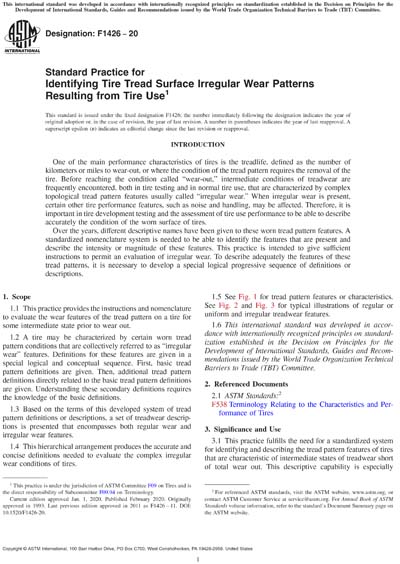Most recent
ASTM F1426-20
Standard Practice for Identifying Tire Tread Surface Irregular Wear Patterns Resulting from Tire Use
1.1 This practice provides the instructions and nomenclature to evaluate the wear features of the tread pattern on a tire for some intermediate state prior to wear out.
1.2 A tire may be characterized by certain worn tread pattern conditions that are collectively referred to as “irregular wear” features. Definitions for these features are given in a special logical and conceptual sequence. First, basic tread pattern definitions are given. Then, additional tread pattern definitions directly related to the basic tread pattern definitions are given. Understanding these secondary definitions requires the knowledge of the basic definitions.
1.3 Based on the terms of this developed system of tread pattern definitions or descriptions, a set of treadwear descriptions is presented that encompasses both regular wear and irregular wear features.
1.4 This hierarchical arrangement produces the accurate and concise definitions needed to evaluate the complex irregular wear conditions of tires.
1.5 See Fig. 1 for tread pattern features or characteristics. See Fig. 2 and Fig. 3 for typical illustrations of regular or uniform and irregular treadwear features.
FIG. 1 Tread Pattern Characteristics


FIG. 2 Uniform or Regular Wear


FIG. 3 Types of Irregular Wear


FIG. 3 Types of Irregular Wear (continued)


FIG. 3 Types of Irregular Wear (continued)


FIG. 3 Types of Irregular Wear (continued)


FIG. 3 Types of Irregular Wear (continued)


Note 1: Images courtesy of The Technology & Maintenance Council of the American Trucking Associations, reference Radial Tire Conditions Analysis Guide, Item # T0121. For more information, contact TMC: (703) 838-1763; [email protected]; http://tmc.trucking.org.
Note 2: Images courtesy of the Tire Industry Association, reference Passenger and Light Truck Tire Conditions Manual, www.tireindustry.org.
Note 3: In illustrations (h), (l), and (m), the ‘light’ or ‘featureless’ areas indicate high wear rate zones.
Note 4: Images courtesy of the U.S. Tire Manufacturers Association, reference Care and Service of Passenger and Light Truck Tires Manual, www.ustires.org.
1.6 This international standard was developed in accordance with internationally recognized principles on standardization established in the Decision on Principles for the Development of International Standards, Guides and Recommendations issued by the World Trade Organization Technical Barriers to Trade (TBT) Committee.
Content Provider
ASTM International [astm]






